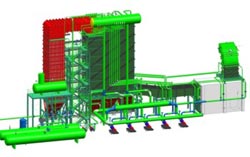Steam of hot flue gases saves energy at steel mills

<br>
In the past, flue gases were usually not utilized, so the energy they carried was lost. The system consists of steam boilers, pipes, water tanks, and pumps and can be directly integrated into the existing flue gas cooling system. Theoretically, the system could entirely replace conventional cooling.
A feasibility study carried out at a steel mill in Turkey revealed potential savings of 44.5 kilowatt hours of electricity per ton of steel produced. That corresponds to around ten percent of the electrical energy that is normally required. If the steam were used to preheat the feed water for the steel mill's power plant, for example, the mill would save 45,000 tons of coal per year.
Electric arc furnaces melt steel scrap under arcs heated to a temperature of about 3,500 °C using high-voltage electricity. Depending on the specific furnace operation, up to one third of the energy used escapes in the flue gases. Normally these flue gases – which can be as hot as 1,800 °C – are extracted from the furnace through water-cooled pipes. Because this cooling water circulates within a closed system, it cannot be permitted to form steam. Cooling towers dissipate the excess heat.
This is where the solution developed by the experts at Siemens Metals Technologies comes in. The hot flue gas is diverted into a steam generator, where it flows around pipes filled with water. The heat from the gas turns the water into steam. A sophisticated system of nested heating surfaces ensures that heat is transferred from the flue gas as efficiently as possible.
Special recirculation pumps ensure that the steam boiler is adequately cooled. The system can handle fluctuations in flue gas temperature and volume, and it is specially designed to deal with the high levels of dust, some of which is corrosive, in the flue gas. Continuous steam production, such as that required for generating electricity, can be achieved through the installation of optional storage buffers known as “steam accumulators.”
The heat from the flue gas can be recovered even more efficiently if the gas is directed through an “economizer” after it leaves the steam boiler. In the “economizer” the gas flows around a second system of pipes, where the remainder of its heat is used to preheat the feed water for the steam boiler.
The steam generation system has a modular construction and can be easily adapted to the specific requirements of each plant. This makes it especially easy to modernize existing steel mills.
Media Contact
More Information:
http://www.siemens.com/innovationnewsAll latest news from the category: Power and Electrical Engineering
This topic covers issues related to energy generation, conversion, transportation and consumption and how the industry is addressing the challenge of energy efficiency in general.
innovations-report provides in-depth and informative reports and articles on subjects ranging from wind energy, fuel cell technology, solar energy, geothermal energy, petroleum, gas, nuclear engineering, alternative energy and energy efficiency to fusion, hydrogen and superconductor technologies.
Newest articles

Trotting robots reveal emergence of animal gait transitions
A four-legged robot trained with machine learning by EPFL researchers has learned to avoid falls by spontaneously switching between walking, trotting, and pronking – a milestone for roboticists as well…

Innovation promises to prevent power pole-top fires
Engineers in Australia have found a new way to make power-pole insulators resistant to fire and electrical sparking, promising to prevent dangerous pole-top fires and reduce blackouts. Pole-top fires pose…

Possible alternative to antibiotics produced by bacteria
Antibacterial substance from staphylococci discovered with new mechanism of action against natural competitors. Many bacteria produce substances to gain an advantage over competitors in their highly competitive natural environment. Researchers…





















